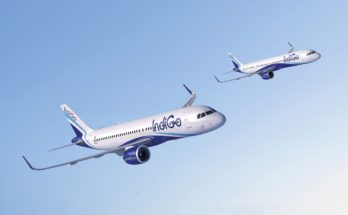
Under a restructuring plan begun almost five years ago, Bombardier has radically narrowed its aerospace focus to business jets and aerostructure production. Three major divestitures have transformed the Canadian company into a much smaller aerospace manufacturer.
Airbus Canada Begins Operation
The most dramatic of these steps was the formation of a joint venture, majority led by Airbus, to take over the CSeries program. This effort, begun in late 2017, became official in July 2018 when Airbus assumed a 50.01 percent controlling stake in the program. The CSeries was quickly rebranded by Airbus as the A220. The two new models in Airbus’ lineup, the A220-100 and A220-300, were formerly known as the CS100 and CS300, respectively.
The CSeries had been a risky venture for the company insofar as it straddles the high end of the regional jet market and the low end of the narrowbody market – hypercompetitive Airbus and Boeing territory. Debt burden over the delayed program had also been a drag on Bombardier in recent years – so much so that in 2016, Québec’s provincial government finalized a $1 billion investment to bail out the CSeries program. In return, Investissement Québec became a minority partner in the CSeries program. As part of the deal, A220 operations will remain in Québec for at least 20 years. The investment introduced a new flow of cash to support the aircraft’s entry into service and production ramp-up. Currently, under Airbus, Investissement Québec holds a 16 percent interest, with Bombardier holding the remaining 34 percent.
In June 2019, C Series Aircraft Limited Partnership (CSALP) was renamed Airbus Canada Limited Partnership to better reflect Airbus’ majority stake. The limited partnership employs approximately 2,200 at its headquarters and manufacturing facilities in Mirabel. The second A220 manufacturing facility in Mobile, Alabama, will start production in the third quarter of 2019.
De Havilland Canada Reborn
This deal was followed by the sale of its Q400 turboprop operations in mid-2019. The program, as well as the storied De Havilland trademark, was acquired by Longview Aircraft Company of Canada Ltd, which is now known as De Havilland Aircraft of Canada Ltd. Longview Aircraft is itself owned by Longview Aviation Capital, which owns Viking Air. Back in 2016, Viking Air bought out Bombardier’s CL-215, CL-215T, and 415 amphibious aircraft programs. With these two acquisitions, all former De Havilland Canada aircraft are once again under the same roof.
MHI Buy May Signal End of CRJ Program
Next on the auction block was the CRJ regional jet program. Under a $550 million deal, Mitsubishi Heavy Industries will acquire maintenance, support, upgrade, marketing and sales activities for the CRJ Series aircraft. The deal also includes service and support network activities located in Montreal and Toronto, as well as in Bridgeport, West Virginia, and Tucson, Arizona.
The deal gives MHI ownership of Bombardier’s regional airliner support network, something that MHI will eventually need in order to support its own regional jet – the Mitsubishi SpaceJet – in North America. In the meantime, it can operate the facilities profitably by supporting the large CRJ fleet in operation.
Most telling is that the deal does not include the CRJ production facility in Mirabel, Quebec. This facility will continue to assemble the CRJ family on behalf of MHI until the current backlog is exhausted, which Bombardier expects to happen in the second half of 2020. So far MHI has been mum on whether it would restart production of the CRJ family at a new site once production ends at Mirabel. Such a move is deemed unlikely due to the expense of creating a new facility at time when MHI needs to focus on the SpaceJet.
Enter Bombardier Aviation
With this triumvirate of deals, Bombardier has consolidated its remaining aerospace operations under a new division, Bombardier Aviation. As part of this streamlining, Bombardier will pursue the divestiture of its Belfast and Morocco aerostructures facilities, which produced components not only for Bombardier but for other aerospace OEMs as well. Airbus has expressed interest in acquiring Bombardier’s A220 wing production plant in Belfast. Aerostructure specialists GKN and Spirit AeroSystems may also be interested in the operations. (See new article : Bombardier Capping Restructuring with Aerostructures Sale to Spirit AeroSystems).
As an OEM, what remains for Bombardier Aviation will be a singular focus on the business jet market via its Global, Challenger, and Learjet brands. Here the company has actually added capacity, acquiring the Global 7500 wing operations in Texas from Triumph. With the company now putting a greater emphasis on the business aircraft market, gaining control of this key aerostructure facility helps secure and speed management of the production ramp-up.
According to FI’s Civil Aircraft Forecast, the business jet market appears to be on the verge of recovery, current stock market volatility notwithstanding. A number of key indicators are trending upward, including economic growth, corporate profits, flight activity, and business and buyer confidence. These economic improvements have helped unlock latent demand that has built up in the market over the past several years. Most importantly, a number of manufacturers, including Bombardier, are transitioning their product lines from older aircraft to new models.

Bombardier’s first entrant in this race, the Global 7500, entered service in December 2018 and is in the midst of a production ramp-up. Looking ahead, the company has introduced several new variants, such as the Global 5500 and 6500, with more powerful and fuel-efficient engines as well as other improvements. These models are aimed at standing out in this competitive market as they compete with new models from Dassault (Falcon 7X) and Gulfstream (G600) for sales.
Bombardier’s management team has taken tough medicine in deconstructing its commercial aerospace operations. With its difficulties behind it, Bombardier Aviation should be a stable and healthy operation in the years ahead.
A military history enthusiast, Richard began at Forecast International as editor of the World Weapons Weekly newsletter. As the Internet grew in importance as a research tool, he helped design the company's Forecast Intelligence Center and currently coordinates the EMarket Alert newsletters for clients. Richard also manages social media efforts, including two new blogs: Defense & Security Monitor, covering defense systems and international issues, and Flight Plan, which focuses on commercial aviation and space systems. For over 30 years, Richard has authored the Defense & Aerospace Companies, Volume I (North America) and Volume II (International) services. The two books provide detailed data on major aerospace and defense contractors. He also edits the International Contractors service, a database that tracks all the contractors involved in the programs covered in the FI library. More recently he was appointed Manager, Information Services Group (ISG), a new unit that encompasses developing outbound content for both Forecast International and Military Periscope.



